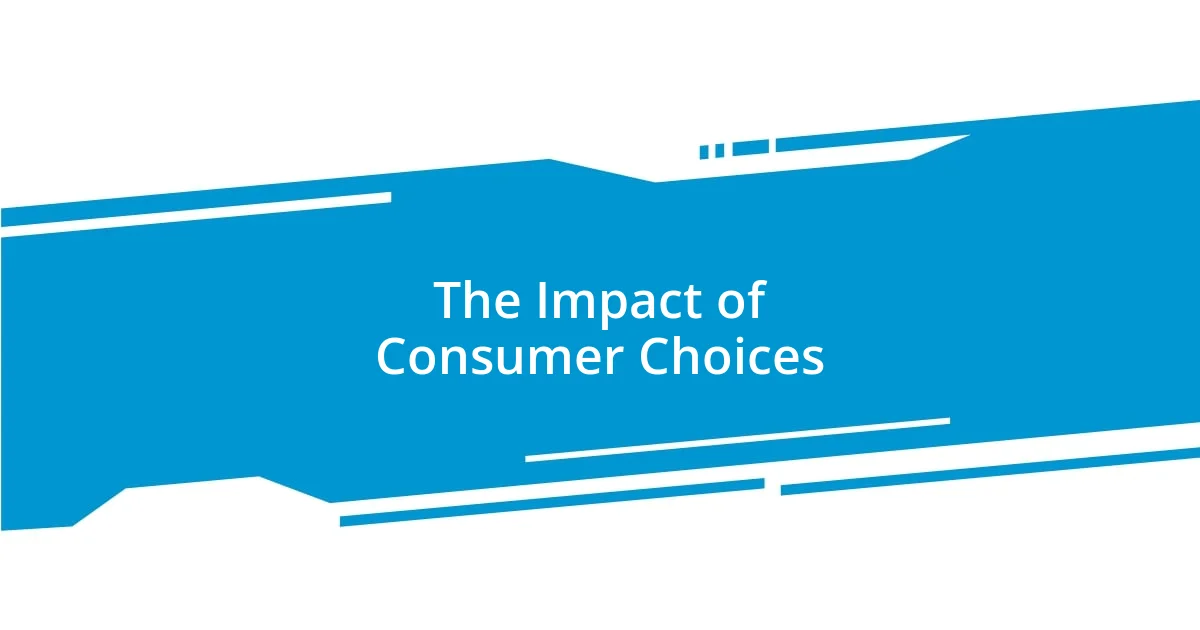Key takeaways:
- Sustainable brands focus on a triple bottom line—profit, people, and the planet—prioritizing transparency, ethical practices, and community engagement.
- Key principles of sustainability include circularity, community engagement, and a genuine commitment to ethical practices, enhancing consumer empowerment and impact.
- Future trends in sustainable branding emphasize the importance of transparency, the use of technology for supply chain tracking, and the adoption of circular economies to reduce waste.

Understanding Sustainable Brands
When I first dove into the world of sustainable brands, it was eye-opening to see how they prioritize not just profit but also people and the planet. This triple bottom line approach reshapes how we think about consumption—what if our purchases could actually contribute to a healthier world? I remember standing in a store, holding a beautifully packaged item, and wondering about its journey: Who made it? Under what conditions?
Sustainable brands operate on principles that extend beyond just using eco-friendly materials. They often focus on transparency, ethical labor practices, and a commitment to reducing their carbon footprint. For instance, I came across a small clothing company that sources its materials from organic farms and pays fair wages to its workers. It struck me how a single choice could support a much larger ethical ecosystem—this realization left me feeling empowered as a consumer.
Another fascinating aspect is the storytelling behind these brands. I once attended a workshop where a founder shared her journey of creating a sustainable skincare line. She emphasized how each product came with not just benefits for the skin but also stories of community collaboration and environmental conservation. Have you ever considered how a product’s story can shape your perception of it? For me, it made all the difference; I began to view my purchases as a way to support brands that align with my values.

Key Principles of Sustainability
Sustainability in branding is anchored on a few essential principles. For one, there’s the concept of circularity, which revolves around designing products with their entire lifecycle in mind. I remember being amazed when learning about brands that incorporate recycling programs—like a shoe company I discovered that allows customers to return their worn-out shoes to be repurposed. It made me reflect on how my own decisions as a consumer could affect the environment long after leaving the store.
Another key principle is community engagement, which facilitates a strong relationship between brands and the people they serve. I vividly recall visiting a local farmer’s market where many vendors emphasized not just sustainable produce but also their commitment to supporting local agricultural practices. It felt reassuring to know that my purchases were directly impacting their community and fostering economic resilience. This connection can turn shopping into something much more meaningful, don’t you think?
Finally, genuine commitment to ethical practices is paramount. I’ve met brand founders who passionately share their journeys of overcoming challenges related to fair wages and ethical sourcing. Their stories remind me that behind each product lies a network of lives being uplifted—or affected. Every time I choose to support a brand that prioritizes these values, I feel a sense of empowerment, knowing I’m contributing to a positive change in the marketplace.
| Principle | Description |
|---|---|
| Circularity | Designing products for reusability and end-of-life recycling. |
| Community Engagement | Building relationships that support local economies and sustainability. |
| Ethical Practices | Commitment to fair labor, sourcing, and transparent business operations. |

Identifying Authentic Sustainable Brands
Recognizing genuine sustainable brands can be tricky, especially with the growing trend of greenwashing—where companies exaggerate their eco-friendliness. I recall browsing an online store, drawn in by bold claims of “eco-friendly” products. But when I dug a little deeper into the brand’s practices and certifications, it became clear that their sustainability narrative was more of a marketing ploy than a commitment. This experience taught me that authentic brands are often transparent about their processes and are willing to share their sourcing details.
To help identify real sustainable brands, consider these key indicators:
- Transparency: Look for clear communication about sourcing, production, and business practices.
- Certifications: Seek third-party certifications like Fair Trade, USDA Organic, or B Corp that confirm their sustainable claims.
- Community Impact: Observe whether the brand actively supports local communities or environmental causes.
- Track Record: Research their history—genuine brands often have a consistent commitment to sustainability over time.
- Engagement: Pay attention to how they interact with their customers—authentic brands welcome questions and feedback.
I’ve experienced firsthand the sense of community that genuine brands foster. At a small, sustainable coffee shop I frequent, the barista shared how they source beans from farmers who are paid fairly, which added dimensions to my daily cup of coffee. It felt wonderful knowing my support was making a direct impact in the lives of those farmers.

Evaluating Brand Sustainability Practices
In evaluating brand sustainability practices, it’s vital to delve into their supply chain transparency. I remember attending a workshop where a founder of a sustainable fashion brand passionately discussed how they trace every material back to its origin. This commitment to transparency not only showcased their dedication but also allowed consumers like me to connect more deeply with the products we choose. Isn’t it reassuring to know where your clothes come from and the hands that made them?
Another significant factor is the brand’s long-term sustainability strategies. I came across a home goods company that not only focuses on sustainable materials but also invests in innovative technologies to reduce water waste in production. Hearing about their proactive measures left me inspired—what a powerful illustration of a brand walking the talk! Brands should not only be reactive to trends but should also anticipate future challenges.
Moreover, assessing community impact can be a game-changer. At a recent local event, I discovered that a skincare brand provides job training for people from underserved communities, teaching them valuable skills. It struck me that such initiatives go beyond just selling products; they’re about empowering people. How often do we evaluate brands on their ability to uplift others? It’s a critical aspect of true sustainability that can enhance our purchasing decisions.

The Impact of Consumer Choices
Consumer choices wield a remarkable power that can shape industries and foster change. I vividly recall a day spent at a local farmers’ market where I chose to support a small vendor selling organic produce. Talking with the farmer about his practices made me realize how even my small purchase contributed to sustainable agriculture. These choices are building a collective voice that urges brands to adopt more responsible practices.
As I navigated my journey toward conscious consumerism, I often found myself pondering: how often do I consider the impact of what I buy? When I switched to a sustainable clothing brand, I not only appreciated their eco-friendly materials but also felt a sense of pride knowing my fashion choices supported ethical labor practices. This experience reinforced my belief that every dollar spent sends a message, encouraging brands to prioritize sustainability over mere profits.
Furthermore, I’ve noticed a ripple effect in my social circles—when friends see me make sustainable choices, it sparks their curiosity. Just last week, a friend asked me about my favorite eco-friendly beauty brand after I mentioned their plastic-free packaging. It’s rewarding to see how our choices can inspire others to rethink their habits, creating a community that values sustainability. Isn’t it fascinating how the decisions we make ripple out and influence those around us?

Building a Sustainable Brand Strategy
Building a sustainable brand strategy starts with a clear vision. I recall brainstorming for my own side project, where I realized the importance of setting measurable sustainability goals. It’s one thing to say you’re committed to being eco-friendly; it’s another to lay out a roadmap that includes specific targets, like reducing carbon emissions by a certain percentage each year. How can you inspire others without a tangible plan?
Equally important is engaging your audience authentically. I remember crafting a campaign for a local brand that revolved around their commitment to using recycled materials. When they shared real stories from the workers behind the process, it created an emotional connection with the customers. Don’t you think that authenticity resonates more than polished marketing jargon? Consumers appreciate knowing the faces behind the product.
Lastly, fostering community partnerships can amplify your impact. During my time volunteering for an environmental non-profit, I saw firsthand how brands collaborating with local organizations can strengthen their sustainable efforts. For example, a coffee shop teamed up with a local reforestation initiative, planting a tree for every cup sold. This partnership not only enriched their brand values but also allowed their customers to feel they were part of something bigger. Have you considered how your brand’s network can enhance your sustainability mission?

Future Trends in Sustainable Branding
As I look to the future of sustainable branding, I can’t help but notice the increasing importance of transparency. Brands that openly share their sourcing and production processes are not just building trust; they’re also creating a narrative that consumers find compelling. For instance, I recently encountered a skincare brand that detailed the journey of their ingredients from farm to shelf. It made me feel more connected to the products, as if I had a stake in their story. Isn’t it inspiring to think that transparency could be the heart of brand loyalty moving forward?
Embracing technology will also be a game-changer in sustainable branding. I remember attending a workshop where we delved into the potential of blockchain for supply chain transparency. This technology can track where materials come from and how they’re made, ensuring ethical practices along the way. Imagine a world where scanning a QR code on a product reveals its entire life cycle! How empowering would that be for consumers looking to make informed choices?
Additionally, I see a rising trend in circular economies, where brands design products to be reused or recycled. Just the other day, I read about a furniture company that encourages customers to return old pieces for refurbishment. It made me reflect on my own clutter at home; it’s fascinating to consider how my old items could be given new life rather than ending up in a landfill. Could this shift in mindset redefine how we see ownership and waste in our consumer-driven society?
















